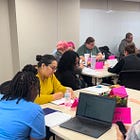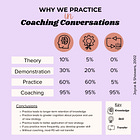The Three Conditions for Healthy Autonomy
Why Freedom Doesn’t Work Without Clarity, Capacity, and Credibility
After publishing this week’s post on the Trust Friction Curve, I got a bunch of messages from coaches and leaders that boiled down to this:
“Okay, but how do I know if someone’s ready for more autonomy?”
Fair question. Here’s the short answer:
Autonomy should never be earned like a prize.
It should be designed for—with intention, feedback, and system support.
Just as kids need structure to feel safe, adults need scaffolding to be successful in freedom.
Let’s talk about the three conditions that make autonomy not just possible—but powerful.
The Autonomy Equation
Autonomy works when three forces are in place:
1. Clarity → Do I know what success looks like?
2. Capacity → Do I have the skills, time, and resources to do it?
3. Credibility → Do others believe I can lead in this space—and do I believe it too?
If even one of these is missing, autonomy either flops… or burns people out.
Condition 1: Clarity
This is the most underrated failure point.
You can’t say “we trust our teachers” if no one knows what they’re being trusted to do.
Signs You’re Missing Clarity:
People constantly ask, “What exactly do you want?”
The same initiative looks totally different across classrooms.
Teachers are afraid to take initiative for fear they’ll get it wrong.
Clarity isn’t control. It’s compassion.
Build It By:
Defining what “strong” looks like (rubrics, exemplars, success criteria)
Offering clear non-negotiables + areas of choice
Modeling desired behaviors or practices
Condition 2: Capacity
This is where most “empowerment” plans quietly collapse.
You gave them autonomy… but they didn’t have the planning time. Or the instructional toolbox. Or the emotional margin to try something new.
So they either fake it, freeze, or flame out.
Signs You’re Missing Capacity:
Teachers opt out or passively comply
Excitement fades into frustration
You hear: “I’m not ready” or “This feels like too much right now”
Build It By:
Allocating time and PD to support the change
Removing conflicting priorities or “initiative stacking”
Coaching into skill gaps without shame
You can’t empower people to fly if you’ve tied their hands behind their back.
Condition 3: Credibility
This one’s sneaky.
You might think someone is ready. But if they don’t believe they are—or if their colleagues don’t believe it—autonomy gets sabotaged by doubt.
Signs You’re Missing Credibility:
People over-explain or over-apologize when taking initiative
Trust fractures between teams (“They’re not doing it right”)
Strong staff refuse autonomy because they’re afraid of being judged
Build It By:
Naming strengths publicly and often
Giving people visible wins in low-stakes ways
Providing feedback that affirms judgment, not just performance
Credibility is built when people feel seen, not just assessed.
Use This to Diagnose Your Autonomy Strategy
Let’s say your school is trying to empower teacher teams to co-design common formative assessments.
If it’s not working, ask:
Do we have clarity? Do teams know what “aligned” and “rigorous” mean in this context?
Do we have capacity? Have we built time into the calendar for this, and do they know how to write a good assessment?
Do we have credibility? Do the teachers feel like their work will be respected—and do leaders act like it?
If any of those are missing, that’s not a failure of autonomy. That’s a design gap.
Leader Reflection
Ask yourself:
Where have I confused giving autonomy with “getting out of the way”?
Do my people know what great looks like—and believe they’re capable of it?
Which of the three conditions is my growth edge?
Stack It Like This
Here’s a simple, sustainable way to scaffold autonomy:
Autonomy isn’t a leap of faith.
It’s a design choice—backed by structure and belief.
Coming Next…
In Part 7, we’ll talk about how to design trust into your systems—so that autonomy doesn’t depend on personality or proximity, but shows up consistently across your school or district.
But for now, here’s your challenge: Where are you handing people autonomy—without the scaffolding that makes it work?
What would it look like to fix that instead of blaming the person?












This series is what I need right now! My supervisor and I are talking about how to build teacher capacity and how you talk about it really resonates with me as a coach. Can’t wait for the next one!!!